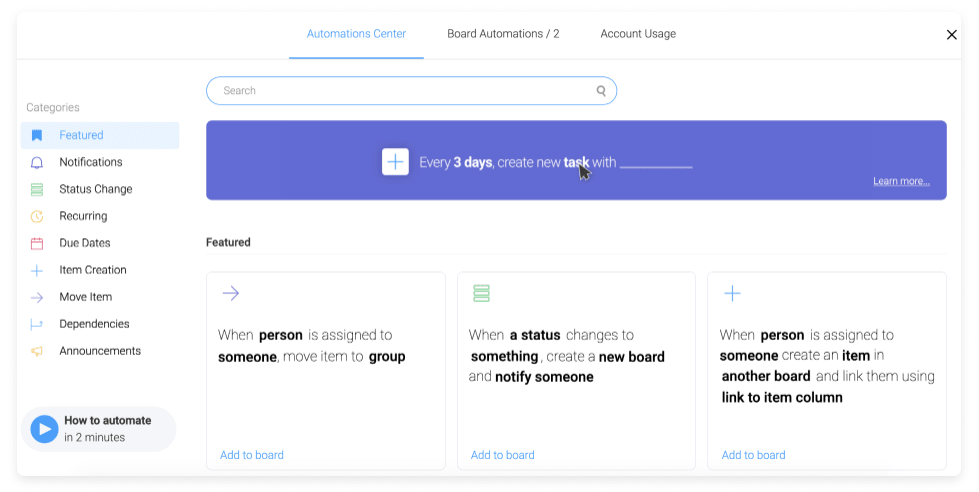How to improve your business processes — a guide to making it simple
Blog: Monday Project Management Blog
2020 has been a complicated and challenging year.
For many of us, it’s been a time to reflect on the core things that matter to us and discard all the other stuff. To look at our lives and make them simpler and easier.
As we head into 2021, why not use the same approach for your business?
This comprehensive guide will explore some of the common process improvement methodologies, outline the steps you need to streamline your processes, and suggest how project management software can help you optimize your business.
What is process improvement?
Firstly, let’s define what a process actually is. A process is a series of steps or actions that are taken in order to reach a particular goal or outcome.
This means process improvement is a method by which you review that series of steps and look at whether it could be made better. This might involve eliminating extra steps, running two or more of those steps concurrently, improving a step (say, by adopting new technologies), or re-ordering the steps to make the process more efficient.
Within the business environment, there is a systematic approach to process improvement that involves:
- Identifying areas where things aren’t working as well as they should be
- Analyzing what options there are to improve those areas
- Implementing new solutions to improve quality or efficiency
- Monitoring whether those new solutions are having the desired effect
What benefits can I expect from improved processes?
The end goal of process improvement is to optimize performance by removing waste, duplication, or friction from the process.
While the key purpose is to deliver a better product or service for customers (and increase company profitability), there are 3 additional benefits that process improvement can lead to.
1. Higher productivity
Bottlenecks can be frustrating and lead to delays. Through workflow analysis, you can identify steps in a process where there’s a repeated logjam or where errors are frequently made.
In questioning why those things are happening, you can uncover the real reason processes aren’t working as well as they could be.
By fixing the root cause of the problem, you can reduce the time and effort required to complete the task and to fix errors that are made. Increased output for less input equals higher productivity levels.
And with 70% of workers feeling stressed by their workload, that’s significant. Which leads us on to…
2. Happier employees
No one loves wasting their time on inefficient or frustrating tasks.
By optimizing your processes and automating administrative tasks, you can free up your employees to tackle work where they can create real value.
And we all know that doing work that feels meaningful is a much better recipe for job satisfaction than work that feels uninspiring or pointless.
Building a workplace environment that appreciates mistakes as opportunities to learn and improve, also reduces employee stress and results in a culture of honesty and shared responsibility.
3. Competitive advantage
It should come as no surprise that being able to do more with less creates a business advantage.
With 83% of businesses finding it challenging to source suitable employees, retention of top talent is incredibly important to staying competitive in the market.
And, let’s be honest, most of us would prefer to work in a dynamic, streamlined workplace rather than an inefficient, bureaucratic one.
What are some common process improvement methodologies?
There are a number of process improvement methodologies and, within those methodologies, there are a number of different tools you can use to help your analysis.
All the methodologies focus on optimizing your business processes but the way they do that is subtly different.
Let’s take a look at 4 of the most popular methodologies:
Kaizen
Kaizen is a Japanese business philosophy that literally means ‘change for the better’.
The emphasis is on continuous improvement and the belief that everyone in the company has a responsibility for making those improvements.
This means that businesses adopting Kaizen work hard to build a culture where mistakes aren’t punished but instead learned from and used as a tool for improvement.
Six Sigma
Famous for its use of ‘karate belts’ to indicate the experience of its practitioners, Six Sigma is a process improvement methodology focused on reducing process variation and minimizing errors in production.
The Six Sigma methodology aims to have only 3.4 defects for every 1 million outcomes or products.
The customer is the ultimate driver behind the Six Sigma methodology. Fewer errors mean increased customer satisfaction with a product or service which builds customer loyalty and repeat business.
In the case of non-profits, lowering administrative overheads, through process standardization, means a greater percentage of each donation goes to the cause it supports.
Lean Thinking
Lean thinking is often used in combination with Six Sigma (and given the catchy name, Lean Six Sigma) as a process to maximize efficiency.
First used within Toyota car manufacturing, Lean process improvement is focused on eliminating ‘waste’ from the process.
In this method, a technique called ‘value stream mapping’ is used to examine the process from end-to-end and identify those activities that create value for the customer (and hence contribute to profit) and those that don’t.
Once the process mapping is complete, emphasis is put on reducing and streamlining all activity that doesn’t directly contribute to increased value.
Total Quality Management (TQM)
Total Quality Management is a methodology that looks beyond a single business process to identify where the organization as a whole can make improvements to its efficiency and productivity.
Like other methodologies, the main focus is on delivering value to the customer.
Irrespective of the methodology you follow there are some best practice strategies you’ll likely want to implement:
Set quantifiable goals.
It’s important to have some metrics or data to benchmark against when seeking to improve processes. Once you’ve identified where you think an improvement can be made, make a note of the current output so you can measure the impact of steps taken to optimize the process.
Put the customer first.
Many of the improvements made using these methodologies will deliver secondary benefits such as decreased employee frustration or reducing the cost of overheads.
However, for all of them delivering value for the customer should be the primary goal. This means it’s important to know who the customer is, and what’s important to them, so processes can be optimized to meet these expectations.
Leverage technology.
This is definitely one occasion where using technology can be incredibly useful. Manually trying to map a complicated process can be difficult and time-consuming and process improvement software can help.
It’d be ironic if an increase in errors came from the process improvement method itself!
What steps should I follow?
Whichever methodology you follow you’ll need to go through the same main steps:
- Identify the improvement you want to make and quantify its benefit
- Obtain buy-in from stakeholders to change the current process
- Design the process improvement plan
- Test the potential improvement in a pilot phase
- Scale, monitor, and optimize
Let’s look at this in greater detail, using Six Sigma as an example methodology.
Six Sigma uses 2 approaches to completing the above steps depending on if you are looking to improve an existing process or design a new, optimized process. These are known as DMAIC and DMADV respectively.
DMAIC stands for:
- Define: this is about identifying what you know about the expectations of your customers and what’s not currently working for them. Feedback from your customers can help you decide which process you want to focus on improving.
- Measure: at this stage, you need to collect whatever data you have on the current process to set a baseline against which you can measure improvement. Once you’ve identified a suitable metric, set an improvement target.
- Analyze: during the analysis phase, you’ll need to look closer at the reasons why the process is suboptimal. This might involve peeling back the layers to identify the root cause of the problem.
- Improve: this is where you propose and test solutions to improve the process. Make sure you get input from the right people when you’re defining the solution (including those who use or are closest to the process).
- Control: once a solution is identified that shows a measurable improvement to the process, it needs to be recorded and adopted. This might include updating operating instructions or manuals and delivering training for employees.

DMADV has the same first 3 steps but the final 2 are different:
- Design: during this phase you’ll need to brainstorm the process steps, what order they should be completed in, what dependencies they have, and what resources are required to complete the process.
- Verify: test the process to ensure it is working and then embed the new process into business operations.
What tools or methods can help at each stage?
In reading through the steps above, you may well have been thinking, “this makes sense but how exactly do I do any of these things”.
There are a number of process improvement tools, techniques, and frameworks that can help at each stage. We’ll have a look at a few of them now.
Kanban boards
Before doing anything else it’s important to identify what needs to change based on feedback that’s been received.
That might be operational feedback, such as consistently missing targets, qualitative feedback from customers, or one-too-many grumpy watercooler conversations with team members.
Once you’ve identified the process you want to improve, you need to capture the ‘As-Is’ state.
Kanban boards are a great tool for capturing the current process.
Their highly visible nature makes it easy for everyone on the team to clearly see the end-to-end process. Which makes collaborating on ideas for improving the process that much easier.
Root cause analysis
Root cause analysis involves looking deeper than the most obvious cause of the problem to identify contributing challenges and, ultimately, reach the root cause.
The method to undertake root cause analysis is simply asking the question “Why?” a number of times until you feel you’ve really got to the bottom of the issue.
You’re basically playing detective.
For example, imagine you’ve had to refund 20% of all recent orders for a particular product due to defects. You go through the process of asking “Why?” until the real issue emerges.
- Why do orders contain defects? Because factory employees are making mistakes
- Why are factory employees making mistakes? Because they’re overworked
- Why are they overworked? Because we haven’t got enough staff
- Why don’t we have enough staff? Because the factory manager hasn’t hired any
- Why hasn’t the factory manager hired any? Because he doesn’t have the budget or authority to do so
In this simple example, we’ve identified that the root cause is the factory manager lacking the budget and authority to hire new employees to manage the workload.
Asking these questions stops assumptions from being made about the reason for the problem. Without asking these questions, other reasons could have been assumed, such as an employee performance or training issue, or an equipment problem.
If you’re new to this technique you’ll be glad to know that monday.com has a root cause analysis template that can get you started.

Gap analysis
Once you’ve identified the root cause of the problem, then you can start to identify solutions. If we take the example above it might seem obvious that the solution is to increase the budget and authority of the factory manager.
But, what are the consequences of implementing that solution?
- Will the factory manager need extra training in budget management or recruitment?
- What changes to policy or systems need to happen so the factory manager can authorize recruitment spend?
- What happens if there isn’t any extra budget? What else could change?
At this stage, you’ll need to create the ‘To-Be’ state. This is what the future process looks like after it’s been optimized to fix the problem that’s been identified. Once the ‘To-Be’ process has been mapped, gap analysis is conducted to identify the gap between the current and future state processes.
PDCA
This stands for Plan, Do, Check, Act and it’s a method to test and refine any changes you make to a process. Once you’ve decided on a potential solution to improve the process you can use the PDCA cycle to:
- Plan out the solution and how you’ll integrate it into the current process
- Do what needs to be done to set your plan in motion
- Check that the solution is making a difference by comparing its impact to the baseline data you have on the original process
- Act on any feedback you receive during the checking phase to refine and continually improve the process
How can technology help optimize business processes?
The addition of technology isn’t itself enough to deliver process improvements. But, technology can act to enable an improved process.
As we’ve seen above, technology can be used in tools that support process optimization. If you need to capture your ‘As-Is’ process, it’s much easier to map, reorganize, and share a digital Kanban board than it is a wall full of sticky notes rapidly losing their stickiness.
And we happen to know some tip-top project management software (hint: monday.com) with an intuitive, visually-appealing Kanban tool perfectly placed for capturing your processes.
Technology can also be used within processes themselves to make a difference.
For example, the automation of more administrative, repetitive, or manual tasks can mean redeployment of resources to tasks where they can add greater value.
Here’s what task automation looks like in monday.com:

Conclusion
So that’s it. Our comprehensive guide to process improvement.
Assuming you don’t work in an industry that, rightly, demands multi-layered, complex processes (say, nuclear security), it might be time to see what you can do to streamline and optimize your business processes.
Our business process management template can get you started on the road to simplicity. And, right now, that sounds like a journey we’d all like to be on.
The post How to improve your business processes — a guide to making it simple appeared first on monday.com Blog.
Leave a Comment
You must be logged in to post a comment.








